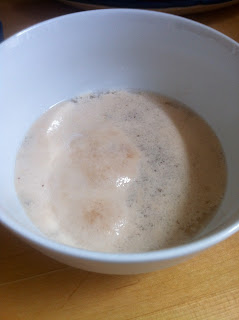.JPG)
About a week ago, I reached the last birthday milestone I will have until I start qualifying for social security: I turned 25 and can now rent a car without scaring the car rental companies with my youth. In honor of this magical day, Justin most thoughtfully gave me a cake stand. Shortly thereafter, he began demanding that I fill the cake stand with cakes. In the same sentence, he insisted that I use the rolling pin he gave me for Hannukah and the bag of whole wheat flour he gave me just because to make a pie. As you may have gathered from reading this blog, pie is not my forte. I have made many a pie in my day, but generally am intimidated either by the delicacy of pie crust or the price of a pound+ of fruit. That said, I had an immensely successful pie attempt recently using aforementioned whole wheat flour, along with some canned pineapple and jarred cherries (true, Julie and Sophie both encountered pits in their slices of pie, but no one died). I had first discovered this fruit combination when I made my first dump cake. What is dump cake, you may ask (assuming you did not grow up in rural Texas, where I believe it is quite well known)? Dump cake is something of a misnomer, as it more closely resembles a crumble. The "dump" part is also not what it sounds like (a garbage dump, obviously). Instead, it refers to the action of dumping a can of pineapple and a can of cherries into a pan, before dumping a box of yellow box cake mix on top and then delicately dumping chunks of butter on top. Bake for an hour and you have dump cake. Unsurprisingly, the union of cherries and pineapple results in a summery, pseudo tropical sweetness, enhanced by the crispy, buttery topping. The adapted pie form of dump cake looked something like this:
.JPG)
A few days after this pie was born (and immediately demolished), the baking bug struck again. I started with a lime meringue pie (post to come), assisted by Luz, Sophie and Catey, and then decided to move on to something with a non-graham cracker crust. I just so happened to have a whole fresh pineapple on hand. I had bought it for the purpose of consuming it as is, but after butchering the thing, it quickly became clear that a whole pineapple is a lot of pineapple. Justin had brought me some fresh cherries the day before, and these were also sitting around that evening. The idea of pitting a bag of cherries seriously clashed with my lazy style. Luckily, Catey was more than happy to rise to the occasion. While I threw together a pie crust, she halved and pitted each and every cherry. Here is how the rest went:
Pineapple-cherry pie from scratch
Pie crust part:
(adapted from Bob's Red Mill)
- 2 cups whole wheat flour (I used Bob's Red Mill because I'm classy)
- 3/4 cups butter (unsalted is good, but it's OK to use some salted if you like salt)
- 1 tsp salt
- 3-6 tbsp ice water (half the water can be substituted with vodka if you have some handy)
Pie part:
- 1 pineapple, diced (minus about 1 cup for eating)
- about 2 cups cherries, pitted
- 1/2 cup water
- 1/4-1/2 cup sugar (to taste. Also depends on sweetness of the fruit you are using)
- 4 tbsp cornstarch
If you have a food processor, use this to make the crust (if not, knives, a pie cutter or hands will work). Place the flour and salt in the food processor. Pulse a few times to blend. Add the butter, cut into chunks, and blend until the mixture is in course chunks. Add the water one tablespoon at a time, mixing after each addition. When the mixture comes together in one clump as it is mixed, the crust is done. Separate dough into two pieces, wrap in plastic wrap and refrigerate for about 30 minutes.
Preheat oven to 350˚ F. Roll out the larger piece of dough (one will be larger. No one is perfect) on a floured surface. Transfer the dough into an 8 inch pie pan. (Note: the whole wheat flour makes this dough very fragile. Don't be alarmed if it seems to be cracking or breaking more than usual. Just pinch it back together. Handle the dough as little as possible for maximum flakiness). Bake the crust for about 10-13 minutes, or until just starting to brown. (I didn't use pie weights and it turned out fine, but feel free to use something to keep the dough from shrinking or bubbling). Remove crust from the oven to cool.
While the crust is cooling, begin on the filling. Place the fruit, sugar and water in a medium pot. Bring water to boil then reduce heat to medium, stirring frequently. Simmer until fruit starts to cook down and the liquid is slightly syrupy, about 15-20 minutes. Add the corn starch and stir, still over low-medium heat, until the mixture thickens.
.JPG)
Roll out the other half of the dough on a floured surface. If your lovely friend gave you pie crust cutters for your birthday, use one to punch out cute shapes to decorate the top of the pie. If not, you can make a lattice, or just a full top crust. If you do a top crust, be sure to make some holes in the top for steam to escape.
Pour the filling into the crust and decorate the top with your design of choice. Bake for 35-45 minutes, or until crust is cooked through. Let cool for as long as you can resist before slicing and devouring.






.JPG)
.JPG)
.JPG)
.JPG)

.JPG)
.JPG)
.JPG)
.JPG)










